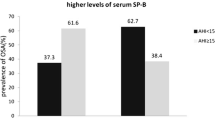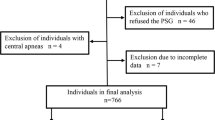Abstract
Purpose
Previous studies have shown that surfactant proteins are affected by oxygen concentration and mechanic stretches, although the alteration of serum surfactant proteins in individuals with obstructive sleep apnea (OSA) is still unclear. Therefore, the aim of this study is to examine whether serum concentrations of surfactant proteins A and D are altered and related to hypopnea index (HI) in OSA.
Methods
This is a cross-sectional study. Consecutive 140 males, suspicious of OSA, were studied. OSA was determined by PSG and polysomnographic data examined. Subjects with HI ≥ 10.1/h were classified as higher HI group and those with HI < 10.1/h as lower HI group. Hs-CRP, HbA1C, and FBG were determined by standard methods and Krebs von den Lungen-6 (KL-6), surfactant protein-A (SP-A), and surfactant protein-D (SP-D) by ELISA.
Results
OSA was diagnosed in 110 patients (78.5 %). Mild, moderate, and severe OSA constitutes 26.4, 27.8, and 24.3 %, respectively. Mean age was 44.6 ± 7.65 years. Subjects with higher HI had lower SP-A (139.54. ± 32.94 vs 158.2 ± 38.9 ng/L, p = 0.005) and SP-D (16.54 ± 3.67 vs 18.10 ± 3.48 ng/L, p = 0.014) compared to those with lower HI. Nocturnal HI was strongly correlated with serum levels of SP-A (r = 0.343, p = 0.012) and SP-D (r = 0.504, p < 0.001) and are inversely associated with circulating SP-A and SP-D levels, even after adjusting for age and body mass index in nonsmoking subjects.
Conclusions
Circulating SP-A and SP-D levels are decreased in some individuals with higher HI in OSA, possibly reflecting severity of hypoxia in OSA.


Similar content being viewed by others
Abbreviations
- OSA:
-
Obstructive sleep apnea
- ATII:
-
Alveolar type II cells
- PSG:
-
Polysomnography
- BMI:
-
Body mass index
- HbA1C:
-
Hemoglobin A1C
- FBG:
-
Fasting blood glucose
- SP-A:
-
Surfactant protein-A
- SP-D:
-
Surfactant protein-D
- KL-6:
-
Krebs von den Lungen-6
- AHI:
-
Apnea/hypopnea index
- HI:
-
Hypopnea index
- AI:
-
Apnea index
- LSaO2 :
-
Lowest oxyhemoglobin saturation
- MSaO2 :
-
Mean arterial oxygen saturation
- ODI3 :
-
Oxygen desaturation index of 3 %
- ODI4 :
-
Oxygen desaturation index of 4 %
- TST90:
-
The total sleep time with oxyhemoglobin saturation at <90 %
- BP:
-
Blood pressure
References
Li JJ, Appleton SL, Wittert GA et al (2014) The relationship between functional health literacy and obstructive sleep apnea and its related risk factors and comorbidities in a population cohort of men. Sleep 37:571–578
Sánchez-de-la-Torre M, Campos-Rodriguez F, Barbé F (2013) Obstructive sleep apnoea and cardiovascular disease. Lancet Respir Med 1:61–72
Wasicko MJ, Erlichman JS, Leiter JC (1993) Control of segmental upper airway resistance in patients with obstructive sleep apnea. J Appl Physiol 74:2694–2703
Kimoff RJ, Hamid Q, Divangahi M et al (2011) Increased upper airway cytokines and oxidative stress in severe obstructive sleep apnoea. Eur Respir J 38:89–97
Aihara K, Oga T, Chihara Y et al (2013) Analysis of systemic and airway inflammation in obstructive sleep apnea. Sleep Breath 17:597–604
Sarıman N, Levent E, Cubuk R et al (2011) Bronchial hyperreactivity and airway wall thickening in obstructive sleep apnea patients. Sleep Breath 15:341–350
Crouch E, Parghi D, Kuan SF et al (1992) Surfactant protein D: subcellular localization in non ciliated bronchiolar epithelial cells. Am J Physiol 263:60–66
Kishore U, Greenhough TJ, Waters P et al (2006) Surfactant proteins SP-A and SP-D: structure, function and receptors. Mol Immunol 43:1293–1315
Takahashi H, Fujishima T, Koba H et al (2000) Serum surfactant proteins A and D as prognostic factors in idiopathic pulmonary fibrosis and their relationship to disease extent. Am J Respir Crit Care Med 162:1109–1114
Ohnishi H, Yokoyama A, Kondo K et al (2002) Comparative study of KL-6, surfactant protein-A, surfactant protein-D, and monocyte chemoattractant protein-1 as serum markers for interstitial lung diseases. Am J Respir Crit Care Med 165:378–381
Stapleton RD, Dixon AE, Parsons PE et al (2010) Acute respiratory distress syndrome network. The association between BMI and plasma cytokine levels in patients with acute lung injury. Chest 138:568–577
White CW, Greene KE, Allen CB et al (2001) Elevated expression of surfactant proteins in newborn rats during adaptation to hyperoxia. Am J Respir Cell Mol Biol 25:51–59
Acarregui MJ, Snyder JM, Mendelson CR (1993) Oxygen modulates the differentiation of human fetal lung in vitro and its responsiveness to cAMP. Am J Physiol 264:465–474
Vives MF, Caspar-Bauguil S, Aliouat EM et al (2008) Hypobaric hypoxia-related impairment of pulmonary surfactant proteins A and D did not favour Pneumocystis carinii Frenkel 1999 growth in non-immunocompromised rats. Parasite 15:53–64
Wirtz HR, Dobbs LG (1990) Calcium mobilization and exocytosis after one mechanical stretch of lung epithelial cells. Science 250:1266–1269
Arold SP, Bartolák-Suki E, Suki B (2009) Variable stretch pattern enhances surfactant secretion in alveolar type II cells in culture. Am J Physiol Lung Cell Mol Physiol 296:574–581
Sanchez-Esteban J, Cicchiello LA, Wang Y et al (2001) Mechanical stretch promotes alveolar epithelial type II cell differentiation. J Appl Physiol 91:589–595
Kuroki Y, Takahashi H, Chiba H et al (1998) Surfactant proteins A and D: disease markers. Biochim Biophys Acta 1408:334–345
Aihara K, Oga T, Harada Y et al (2011) Comparison of biomarkers of subclinical lung injury in obstructive sleep apnea. Respir Med 105:939–945
Digeronimo RJ, Mustafa SB, Ryan RM et al (2007) Mechanical ventilation down-regulates surfactant protein A and keratinocyte growth factor expression in premature rabbits. Pediatr Res 62:277–282
Bailey TC, Maruscak AA, Petersen A et al (2006) Physiological effects of oxidized exogenous surfactant in vivo: effects of high tidal volume and surfactant protein A. Am J Physiol Lung Cell Mol Physiol 291:703–709
Reinke C, Bevans-Fonti S, Grigoryev DN et al (2011) Chronic intermittent hypoxia induces lung growth in adult mice. Am J Physiol Lung Cell Mol Physiol 300:266–273
Orgeig S, Crittenden TA, Marchant C et al (2010) Intrauterine growth restriction delays surfactant protein maturation in the sheep fetus. Am J Physiol Lung Cell Mol Physiol 298:575–583
Qiu L, Deng C, Fu Z et al (2011) The role of transforming growth factors beta1 and beta3 in pre- and post-natal pulmonary surfactant development. Cell Biol Int 35:287–292
Romero-Corral A, Caples SM, Lopez-Jimenez F et al (2010) Interactions between obesity and obstructive sleep apnea: implications for treatment. Chest 137:711–719
Babb TG, Wyrick BL, DeLorey DS et al (2008) Fat distribution and end-expiratory lung volume in lean and obese men and women. Chest 134:704–711
Watson RA, Pride NB (2005) Postural changes in lung volumes and respiratory resistance in subjects with obesity. J Appl Physiol 98:512–517
Mazur W, Toljamo T, Ohlmeier S et al (2011) Elevation of surfactant protein A in plasma and sputum in cigarette smokers. Eur Respir J 38:277–284
Ilumets H, Mazur W, Toljamo T et al (2011) Ageing and smoking contribute to plasma surfactant proteins and protease imbalance with correlations to airway obstruction. BMC Pulm Med 19:11–19
Van Miert E, Sardella A, Bernard A (2011) Biomarkers of early respiratory effects in smoking adolescents. Eur Respir J 38:1287–1293
Acknowledgments
The authors wish to thank Professor Alberto Zanchetti and Zhang Qinghua for their constructive expertise. We also thank Dr. Meng Jing, Li Juan, and Cai Li for their invaluable contribution with the distribution and collection of the questionnaire survey. This study was supported by National Natural Science Foundation of China (grant number: 81260017)
Conflict of interest
The authors declare that they have no conflict of interest.
Author information
Authors and Affiliations
Corresponding author
Rights and permissions
About this article
Cite this article
Liang, S., Li, N., Heizhati, M. et al. What do changes in concentrations of serum surfactant proteins A and D in OSA mean?. Sleep Breath 19, 955–962 (2015). https://doi.org/10.1007/s11325-014-1106-6
Received:
Revised:
Accepted:
Published:
Issue Date:
DOI: https://doi.org/10.1007/s11325-014-1106-6




